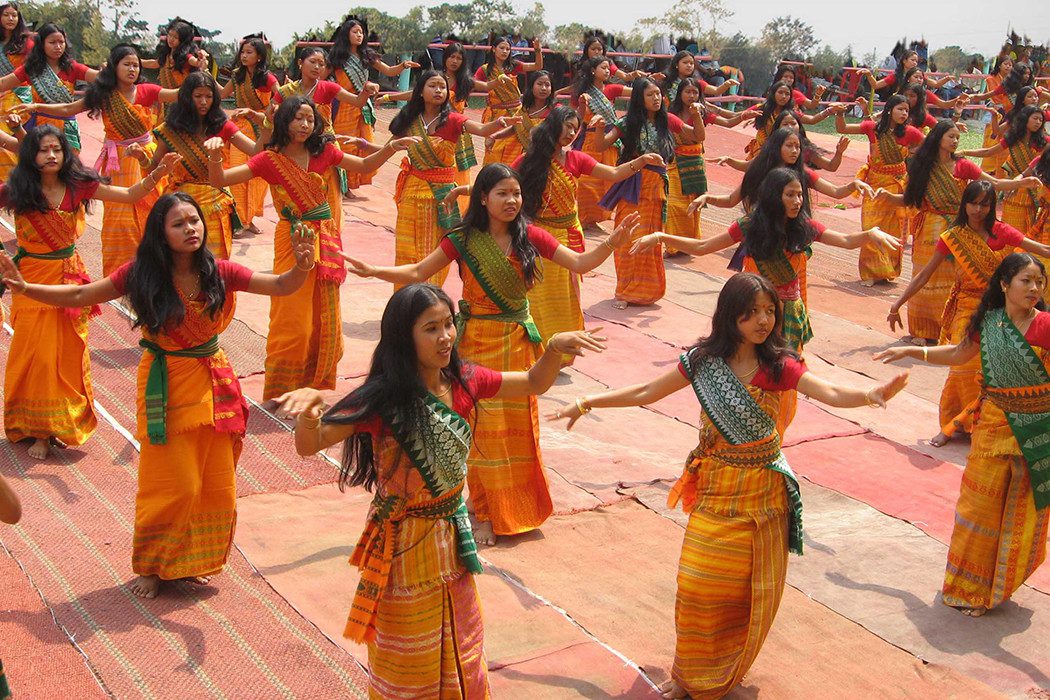Indigenous communities in the Northeast consider dance a lived, vital reality deeply connected with the personal and social.
As an expression of human behaviour that is simultaneously an exercise in physical agency and a manifestation of the metaphysical, dance may be interpreted as a socio-cultural and political gesture which locates itself in complex and ever-changing semiotic systems.As Judith Hanna says:
Dance is a whole complex of communication symbols, a vehicle for conceptualization. It may be a paralanguage, a semiotic system like articulate speech, made up of signifiers that refer to things other than themselves. Substantively, information necessary to maintain a society’s or group’s cultural patterns, to help it attain its goals, to adapt to its environment, to become integrated, or to change may be communicated. (Hanna 1979: 26)
Indigenous communities from the Northeast of India consider dance to be a lived, vital reality deeply connected with the personal and the social. The Tiwa community celebrates the vibrant and youthful festival of Sagramisawa. The dance is performed during the rice pounding activity with the rhythmic sound and movement of the pounding pestle. During Pisu, the celebration of spring, a loosely structured dance is performed, which begins with spontaneous gestures between men and women, assembled together. Ceremonies for the Barat rituals are accompanied by special wood and bamboo instruments reflecting bird and animal motifs being used as a clapping device.
Most Bodo dances are associated with the Kherai festival in the month of November. Associated with the worship of various deities, dances such as Bagarumba and Bordoisikila represent different facets of Mother Nature.
Most Bodo dances are associated with the Kherai festival in the month of November. Associated with the worship of various deities, dances such as Bagarumba and Bordoisikila represent different facets of Mother Nature. The Khapri-Sip-Nai dance by Bodo women or the Daudimi dance is dedicated to gods, priests and believers. Women performers, carrying a sword in one hand and a cloth in the other, communicate through frenzied gestures in the traditional dance arena or sali with the accompaniment of the kham (drum), siphung (flute) and the jotha (cymbals). The Daudimi dance may undoubtedly be seen as a precursor for the Deodhani Nritya.
Male performers of the Haidang songs of the Sonwal Kacharis move through the narrow lanes of the villages with the pace of humming bees until they meet the women performers welcoming them with a dance inside their homes. The local Gira and Girasi dances dedicated to Siva and Parvati by the Deoris follow a transitional path from the family courtyard to the temple courtyard indicating a journey from the mundane to the spiritual joys of life.
Ᾱli-Ᾱi –Liyāng and Porāg are spring time festivals for Misings. In Porāg, the festival involves dancing and singing between neighbouring villages and ends with a prayer dance called ‘Ponu-nunam’. The Ᾱli-Ᾱi –Liyāng dance enumerates stages of cultivation while the dance called O-U- Apnām depicts hunting. Young boys and girls also perform religious dances such as Miboo and erotic dances like Ai-nitam.
Folk dances from the Northeast have invited culture-specific articulations of memory and inheritances and have also drawn reflections on the transformative power of combined media, viz. song, dress and dance. Dynamism, totality, vitality and resilience are integral to the dance forms offering “a kaleidoscope of colours and textures” (Banerjee 1991: 198).
The annual Karbi festival of spring is called Rongker. A three day long festival, it is observed to appease Karbi deities. A crucial part of the festivities involves Rongphu-Rongling-Kangthin, a dance to ward off evil spirits from the village. The harvesting festival of Hacha Kekan also involves spirited dance performances. The Ara-Kora dance is performed during Jhum cultivation. Domahi Alun, similar to the Bihu geet, is accompanied by a dance with swords and shields. Another bamboo dance performed by young boys and girls is known as Okkural kikal.
During the Karbi death ceremony of Chomangkan, various dances are performed by the youths. Chomkan or Karhi is a celebration of death, marked by the lengthy laments of the charhepi or the female guide of the festivities. During the festivities, Karbi youth perform a dance wielding bamboos or banjar called Banjar kekan. Karhi as the celebration of death is fast disappearing as a religious practice. This funerary ritual, which embodies the philosophy of death and rebirth, eroticism and fertility, the art of music and dance, and a communal cultural activity, is also the essence of the cultural edifice of the Karbis.
Folk dances from the Northeast have invited culture-specific articulations of memory and inheritances and have also drawn reflections on the transformative power of combined media.
In her exhaustive work on Traditions of Indian Folk Dance (1976) from the Himalayas to Cape Comorin, Kapila Vatsyayan provides the following categories for folk dance which encapsulates various facets of life in India as follows:
- Hunt/animal imitation dances: Nomads/food gatherers.
- Fertility rites/rituals/magic propitiation/trance: Shift cultivation
- Agricultural functions: Occupational peasant dancing.
- Seasonal dancing and dances belonging to particular festivities/collective activity.
- Dances/dance dramas related to myths/epics—Ramayana/Mahabharata/Gita Govinda
- Devotional dances—to music, semi-classical, sung or played.
- Traditional dance drama forms available to rural/ urban settings.
In the context of an indigenous, eclectic domain, the dances create subjective experience and affective reflections, extending the limits of intellectual understanding. They negotiate involvement of men and women in a communal aesthetic activity, thereby uniting the past and the present in memory in an otherwise mundane existence.
Works cited:
Banerjee, Utpal. 1991. “Folk Theatre: Pageantry and Performance.” India International Centre Quarterly,Vol. 18, No. 4 (WINTER 1991), pp. 198- 200
Hanna, Judith. 1976. To Dance is Human: A Theory of Non-verbal Communication Austin: University of Texas Press.
Smith, Linda Tuhiwai. 1999. Decolonizing Methodologies: Research and Indigenous Peoples. Dunedin: London and New York and University of Otago Press.
Vatsyayan, Kapila. 1976. Traditions of Indian Folk Dance. New Delhi: Indian Book Company



